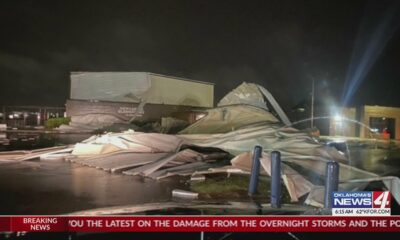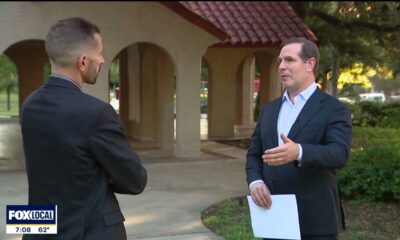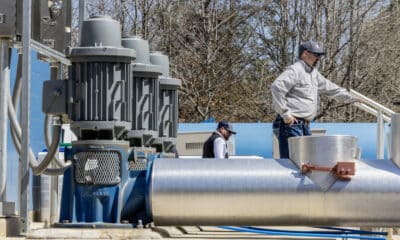Mississippi News
Mississippi ambulance providers fear a system collapse is near
Mississippi ambulance providers fear a system collapse is near
Mississippi’s ambulance system is falling apart, pushing more and more workers from a job that was a hard sell even before the pandemic.
Several of the state’s emergency services leaders told Mississippi Today that while paramedic providers have been troubled for years by an incomplete reimbursement system, low wages and staffing shortages, problems have hit a critical point exacerbated by ongoing hurdles from COVID-19.
They’re not sure how much longer the system can last before swaths of rural Mississippi are left with limited or no access to paramedics’ life-saving care and transportation to hospitals.
“A whole bunch of things are converging at one time that we have never seen before,” said Clyde Deschamp, a licensed paramedic and director at the Mississippi Healthcare Alliance. “A lot of people are of the opinion that the system is going to crash.”
Many in the field are desperate to see the system fixed before it busts, and some worry it’s too late. The root of the problem is a dwindling number of paramedics and emergency medical technicians struggling to get their numbers up in a stress-ridden field known for high turnover.
The shortage nationwide has hit a crisis level, according to the American Ambulance Association. The turnover rate of ambulance workers nationwide was already more than 30% as of July 2021, according to the association.
Mississippi’s rural counties, lower wages, and statistically unhealthy and poor populations have created an especially complex and dire reality for Mississippians.
“When the domino tips, it’s going to be a huge tipping effect,” said Tyler Blalock, a paramedic who runs a 10-person ambulance operation in Franklin County. “One company caves, and an area goes without an ambulance, and the others are stretched too thin they won’t be able to compensate and help cover that area.”
Some ambulance companies in Mississippi say they have given up on job postings because no one is applying, making it harder to quantify just how large the holes are statewide. Mississippi has only about 3,800 people certified to work on ambulances, but providers say workers have been leaving steadily through the pandemic even if their credentials are still active.
“You call 911 and you expect an ambulance to show up in a reasonable amount of time,” said Blalock, 41. “That might not be true right now.”
READ MORE: ‘No one is applying’: Omicron pushes understaffed hospital system into crisis mode
Mississippi doesn’t have enough trained paramedics to fill gaps as emergency workers leave ambulances for better-paying hospital jobs or new fields altogether.
Ambulances are usually staffed by two people: an entry-level or early career emergency medical technician — EMT — and a higher-trained paramedic. To become a paramedic, you first have to become an EMT.
“This is the first time I’ve had to compete with fast food restaurants for entry-level employees,” said Gregory Michael Cole, Covington County Hospital’s ambulance services director. “EMTs start at $14 an hour. You can make that a fast-food place or grocery store.”
And you don’t need to be certified by the state to become a barista or stock shelves in a warehouse. It’s made it all the more difficult for ambulance operators to usher in the next generation of paramedics.
As the highest-level ambulance worker, paramedics administer chest compressions to heart attack sufferers, stabilize broken bones and open blocked airways. They’re trained to deliver babies, authorized to administer medication and their quick-thinking actions can dictate life or death.
Yet, in Mississippi, they’re likely not making much more than $22 an hour — and that’s after staff shortages pushed wages up a few dollars. Job-finder websites such as Indeed and ZipRecruiter put the national average closer to $25 an hour.
“In order to attract a workforce, we need to pay these people,” Cole said. “It’s not that EMS providers and owners don’t want to pay paramedics and EMTs what they’re valued, it’s that they don’t have the financial resources available to do it.”
Ambulances are primarily paid back for their services from a patient’s Medicaid and Medicare plans, which reimburse based on the distance to the hospital. A smaller fraction – usually a quarter, according to Mississippi providers – come from private insurance payouts.
That means if a 911 call doesn’t end with a transport, that ambulance company isn’t getting insurance reimbursements. It doesn’t matter how much time they spent or supplies they used. No hospital means no money.
While the costs of operating ambulances have gone up, reimbursements payouts are stagnant. Wages are, too. And an eligible pool of for-hire paramedics is simply not there.

The latest data from the state’s emergency medical service information system shows there are 1,938 licensed EMTs in Mississippi and 1,765 paramedics.
“Ideally, we would see two to three times as many EMTs as paramedics because, long term, those are the replacements for paramedics that leave the workforce while also filling the need for the EMT role,” said Ryan Wilson, the clinical manager for ambulance company American Medical Response-Central MS.
Even in 2011, when a state health department report showed about 1,200 more licensed ambulance workers than it has now, that ratio was still not at what Wilson described as ideal.
COVID-19 has just compounded the existing shortfalls.
Health care worker shortages have been consistent across all disciplines. But the pandemic has highlighted them in a way most Americans hadn’t seen before: all-day waits to get into the emergency room or hours spent on stretchers in a hallway.
Mississippi hospitals’ nursing shortages have pushed the state’s health care system to new lows. Nurses have consistently left their local hospital jobs to become higher-paid travel nurses with temp companies, forcing hospitals to close beds because there are too few nurses to staff them.
For at least the last five years, paramedics say they have had to deal with a problem they call “wall time.” It’s a direct result of the nursing shortage.
“Wall time” is shorthand for the length of time EMTs and paramedics are waiting with patients before they’re admitted.
Before the pandemic, that could be a 2-hour inconvenience. Now, it’s sometimes an 8-hour holding pattern eating up resources and exhausting workers.
Wilson said it’s not uncommon to have one paramedic with several stretchers set up in hospital hallways managing transported patients who are waiting for a bed to open.
AMR workers set up the makeshift hospital wings so ambulances can get back on the road. But that sort of triaging isn’t sustainable, nor is it always an option – especially for rural county providers that might only have one or two ambulances and just a handful of workers.
The wait times are also hours of work ambulance providers aren’t getting reimbursements for – even as they sit with COVID-19 transfers, using oxygen and other supplies to keep them breathing.
“That’s a tough sell,” Wilson said. “Can you sit in this confined area with a known COVID-positive patient for seven hours? And it’s really kind of like that every day.”
The long wait times hit rural ambulances, like Blalock’s team in Franklin County, the hardest.
Blalock runs a small company – Rural Rapid Response – but is also one of its paramedics. He’s often working three-day, 72-hour shifts as a paramedic and another 40 to 50 hours a week on office and billing work. A lot of his EMTs work two ambulance jobs to up their income.
Rural county drivers are used to long trips when a patient’s needs can’t be met at the local emergency clinic – heart attacks, car wrecks, any severe trauma usually means a trip to a bigger city hospital.
But getting caught up waiting in the bay means hours that the ambulance isn’t around to serve a county that only has one truck to cover hundreds of square miles.
“Rural health care is probably where it’s the scariest because there is such a lack of money,” Blalock said.
When other rural ambulances are held up waiting, he is often the one pitching in to take over their calls.
The tax dollars aren’t there to supplement the costs of a robust system with multiple trucks. and the small ambulance companies willing to work in rural areas themselves can’t easily turn a sustainable profit.
Blalock is a father of four. He’s married to a nurse. He took over the small Franklin County ambulance operation from another paramedic-turned-business-owner who retired.
On a recent weekday night, Blalock didn’t have much downtime. The calls rolled in one after another. His company is the 24-hour provider for Franklin County, which means he is often stepping in extra shifts himself if he’s too short staffed.
He’s almost always short staffed.
“They say I own an ambulance company,” he said. “But the ambulance company owns me.”
The first call of the night came in around 5 p.m. Police wanted a driver checked out: Was he nodding from heroin use or low sugar from his diabetes?
The next call: a woman sick with COVID-19 about 20 miles away. She was scared. Blalock told her to stay hydrated – “for every bottle of Gatorade drink a bottle of water” – he reminded her she could alternate between Tylenol and Ibuprofen to reduce her fever. He checked her vitals, her lungs. He coached her through the virus.
Next, a car wreck. A young driver has a panic attack. Blalock gave her an examination, calmed her down and got her breathing under control. Another car wreck, another 20 miles, soon followed. This woman had severe neck and back pain. They took her to the county hospital.
The last call of the night was an elderly woman with nausea and vomiting. Another 20 miles. But just as they arrived, the family decided to drive the woman to the hospital themselves.
Only one of those trips – the one that ended in the trip to the hospital following the car accident – is eligible to get insurance reimbursements, Blalock said. But she was a Medicaid recipient, he explained, they often don’t pay out on car wrecks. He might have to go through the car insurance company.
Another headache he will have to make time for.
All the other trips that night?
“I tell myself: That was charity,” he said. “I’m a religious person. I contribute to good tidings. But as a business person, a CEO, the reality is: That’s just a loss.”
Emergency services advocates and ambulance providers say the reimbursement system is their biggest challenge. The current setup only contributes to crowded hospitals. A transport may not be necessary, but there is an obvious incentive to do it anyway.
Julia Clarke, the president of the Mississippi Ambulance Alliance, said that some states are creating laws so that ambulances can have treat and release options – a way to still get reimbursed costs without a hospital trip.
People have increasingly been relying on paramedics as a resource to avoid the hospital, making 911 calls without any intention of ever being transported.
The Mississippi Ambulance Alliance recently surveyed providers across the state and estimated total lost revenue from refusals to go to the hospital for last year was $104 million. The same survey and study estimates ambulance companies paid an extra $32 million to cover worker’s overtime costs to keep up with staffing demands.
“Now is the time to use 911 for life-threatening emergencies or limb-threatening emergencies,” Clarke said. “People think because they come in an ambulance they’re going to get put into the first line, that just isn’t true.”
With the hospital system under pressure, paramedics say they’re left cleaning up the mess – their mantra has always been improvise, adapt and overcome.
The Mississippi Healthcare Alliance is funding grants to help ambulances update their equipment. Deschamp, the group’s EMS director, said the alliance is trying to innovate and introduce high school seniors to EMT classes that will double as community college credits. The program’s biggest push will begin this fall.
Ideally, it will get students on the road as EMTs faster and set them up to be paramedics in the future.
“Through workforce development and cooperation with the high schools and community colleges, I’m cautiously optimistic,” Deschamp said.
At AMR, Wilson’s main focus is recruitment. The company handles training itself, covering the costs of the 10-week EMT program and also paying minimum wage to workers while they’re undergoing that training.
The company will also cover the costs to get paramedic training. Paramedics need two years of training the way nurses do – but nurses are looking at all-time high wages four times that of a paramedic.
Setting up a system that covers all educational costs has been the best way to encourage people to enter the pre-hospital path, Wilson said.
The state health department requires a 30-day notice from any ambulance provider if they decide they’re going to cease operation. Right now, the department says it doesn’t have any such pending notices.
It did say, however, it is getting consistent reports of staff shortages.
Blalock says it’s the adrenaline, the calling to help people that keeps him and his lean staff going. Still, they’re desperate for change.
“I think the most frustrating thing is the lack of knowledge or the lack of regard from the government side of things,” he said. “The people with all the power to fix the problems, they either know so little or care so little, and I’m not sure what it is.”
This article first appeared on Mississippi Today and is republished here under a Creative Commons license.
Mississippi News
Events happening this weekend in Mississippi: April 25-27
SUMMARY: This weekend in Mississippi (April 25-27) features a variety of events across Central and Pine Belt regions. Highlights include MiraGotSoul at Vibe Studio in Jackson, a community Dinner and Movie in Clinton, and the Natchez Kite Festival. Enjoy live performances with Sweet Lizzy Project in Natchez and the New Bourbon Street Jazz Band in Clinton. Family-friendly activities include the Native Plant Fest and Community Farmers Market in Jackson. In Hattiesburg, catch the Henry Cho tour and the Downtown Crawfish Jam Music Festival. Overall, it’s a weekend full of entertainment, culture, and fun activities for all ages.
The post Events happening this weekend in Mississippi: April 25-27 appeared first on www.wjtv.com
Mississippi News
Events happening this weekend in Mississippi: April 18-20
SUMMARY: This weekend (April 18-20), Mississippi offers a variety of events for all ages. In Jackson, enjoy Food Truck Friday, a jazz concert, free outdoor movie screenings, and multiple exhibitions including “Of Salt and Spirit” and “Hurricane Katrina: Mississippi Remembers.” For family fun, there’s an Easter Egg Hunt at the Ag Museum and “Bunnies & Butterflies” at MCM. Natchez features the Spring Pilgrimage, Lafayette’s 200th anniversary celebration, and a farmers market. In the Pine Belt, highlights include Live at Five, a Spring Candle-Making Workshop, and Easter events at the Hattiesburg Zoo. Don’t miss the Bluff City Block Party and more!
The post Events happening this weekend in Mississippi: April 18-20 appeared first on www.wjtv.com
Mississippi News
Events happening this weekend in Mississippi: April 11-13
SUMMARY: This weekend in Mississippi (April 11-13), enjoy a variety of events across the state. Highlights include the Eudora Welty Birthday Bash in Jackson, Trivia Night at the Mississippi Museum of Natural Science, and Boots & Bling Fundraiser in Natchez. For family fun, check out the Bunny Bonanza in Jackson or the Easter Egg Hunt in Clinton. The Natchez Concours d’Elegance Car Show and Stranger Than Fiction Film Festival offer cultural experiences, while the 12th Annual Dragon Boat Regatta in Ridgeland and the Hub City Classic Car Show in Hattiesburg provide exciting activities for all ages.
The post Events happening this weekend in Mississippi: April 11-13 appeared first on www.wjtv.com
-

 News from the South - Missouri News Feed4 days ago
News from the South - Missouri News Feed4 days agoMissouri lawmakers on the cusp of legalizing housing discrimination
-

 Mississippi Today2 days ago
Mississippi Today2 days agoDerrick Simmons: Monday’s Confederate Memorial Day recognition is awful for Mississippians
-

 Mississippi Today6 days ago
Mississippi Today6 days agoStruggling water, sewer systems impose ‘astronomic’ rate hikes
-

 Mississippi Today1 day ago
Mississippi Today1 day agoTrump appoints former Gov. Phil Bryant to FEMA Review Council as state awaits ruling on tornadoes
-

 News from the South - West Virginia News Feed6 days ago
News from the South - West Virginia News Feed6 days agoIs West Virginia — and the rest of the country — prepared to care for our seniors?
-

 News from the South - Florida News Feed5 days ago
News from the South - Florida News Feed5 days agoFlorida woman accused of setting fires during burn ban
-

 Mississippi Today5 days ago
Mississippi Today5 days agoParents, providers urge use of unspent TANF for child care
-

 News from the South - Louisiana News Feed6 days ago
News from the South - Louisiana News Feed6 days agoTaxes on vapes and smokeless tobacco advance through committee | Louisiana


















































